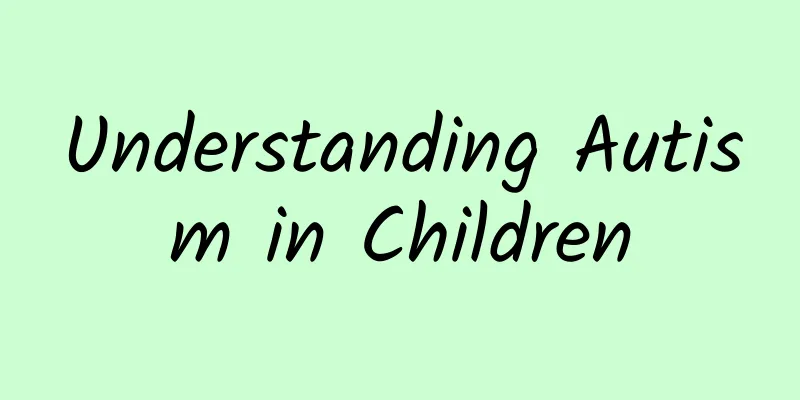Understanding Autism in Children

|
01 What is autism Autism is a developmental brain disorder characterized by social interaction disorders, communication disorders, and repetitive and restricted interests and behaviors. Autism begins before the age of three and becomes obvious after the age of three. The vast majority of children require long-term rehabilitation training and special education support. 02 What are the symptoms of autism? Social interaction disorder: Extreme loneliness, obvious lack of social emotional response, lack of attachment to parents, lack of eye contact with people, rarely or unable to actively communicate; unable to communicate with gaze, expression, posture or gesture; unable to establish partnerships with other children; lack of interest in group games, unable to resonate with group joy; will not seek support or comfort when encountering setbacks, and will not actively provide support or comfort when others encounter setbacks. Communication disorder: Delayed or undeveloped speech development, with a tendency to replace verbal communication with gestures or other forms; stereotyped repetition of some words, with no obvious connection with the environment or ongoing activities; abnormalities in speech tone, speed, rhythm, stress, etc.; obvious impairment of speech comprehension ability; normal speech function development before the age of two, but disorders after the age of two, or even complete inability to speak. Narrow interests and stereotyped repetitive behaviors: stereotyped and narrow interests (for example, focusing on dates, advertisements, weather reports, etc.); special attachment to something; performing special ritual behaviors; stereotyped repetitive movements and postures; special interest in non-essential parts of something (toys) (for example, smells, noises, etc.); unwillingness or refusal to make any changes to personal living environment. 03 Rehabilitation goals for autistic children of different ages In the preschool period, the focus is on basic life skills, emotional dependence and language expression, and the cultivation of self-care skills such as eating, dressing, taking off shoes, and urinating and defecating, as well as language expression skills. In the school age period, the adaptation and learning abilities are reshaped, emotional control and daily routines are established, and independent learning and self-care abilities are cultivated. In the later period, their specialties such as painting and music should be explored. During this stage, family members should actively participate to integrate learning into life. With the participation of the family, find appropriate teaching and training goals, and integrate the teaching content into life to achieve learning goals. The focus of adolescence is to consolidate the acquired learning skills, enhance children's ability to adapt to society, and prevent physical and mental imbalances and emotional fluctuations caused by puberty. 04 Autism Intervention Methods Applied Behavior Analysis (ABA) therapy advocates the use of behaviorist principles and behavior shaping principles, and mainly uses positive reinforcement to promote the development of various abilities of children with autism. The training emphasizes high intensity, individualization, and systematization. The therapeutic education course training for children with autism designs individualized training content based on the characteristics of autistic children's abilities and behaviors, and provides targeted education for the children's defects in language, communication, perception, movement, etc. The core is to enhance autistic children's understanding and obedience of the environment, education and training content. Interpersonal relationship training Including floor time therapy, interpersonal relationship development intervention therapy. Physical therapy repetitive transcranial magnetic stimulation and other sensory integration training can effectively improve the dynamic and static balance ability of autistic patients, and at the same time can improve vestibular imbalance, tactile hypersensitivity and improve intelligence level, but the effect on improving self-care ability is not good; the younger the age and the longer the training time, the more obvious the effect. The purpose of speech training is to correct the child's vocalization and articulation defects. It is a set of targeted behavioral training and methods. The Picture Exchange Communication System (PECS) can improve emotional cognition and expression ability, and visual tools such as pictures, tables, and symbols can improve vocabulary, active and passive expression times, and willingness. Music therapy has found that autistic patients have higher musical abilities and talents than healthy people, and have extraordinary musicality and phonetic abilities. At the same time, music can enhance multi-sensory stimulation, explore the patient's learning ability, and thus promote the improvement of verbal communication ability and skills, shape correct behavior and social emotions, and have good effects on improving active verbal expression, transforming and improving stereotyped behaviors, and enhancing social adaptability. |
<<: What is LSD? It once made Steve Jobs addicted
>>: Did squatting hurt your waist? Put your butt down
Recommend
How to solidify hawthorn cake better? What are the techniques for solidifying hawthorn cake?
We all know that hawthorn cake is a popular pastr...
Uterine pain during menstruation
During menstruation, some female friends will fee...
When to use pregnancy test paper
Pregnancy test strips and ovulation test strips a...
What causes breast pain during breastfeeding?
In fact, sometimes many mothers have breast pain ...
How to make snow fungus and sweet potato soup
I have always liked drinking sugar water, and I l...
What should I do if I have a gynecological wound?
Many mothers will be left with ugly scars after c...
Girls have pain when doing it
When girls have sex, private pain may be caused b...
Year-end physical examination, @diabetics: don’t forget these 3 screenings
In November this year, the top medical journal Th...
Can you drink dried hawthorn soaked in water during menstruation?
You can drink water soaked with dried hawthorn du...
Can uterine prolapse recover naturally?
Uterine prolapse can cause great trouble to patie...
Can I use air conditioning after having an abortion?
Abortion is the same as confinement. After an abo...
HCG comparison table after hydatidiform mole abortion
Hydatidiform mole is actually a benign tumor, but...
There are fleshy bumps on the vulva
Many women have fleshy bumps on their vaginal ope...
Are breast nodules generally easy to treat?
The treatment of breast diseases still needs to b...
What foods are better for gynecological inflammation?
Gynecological inflammation is a very big hidden d...









